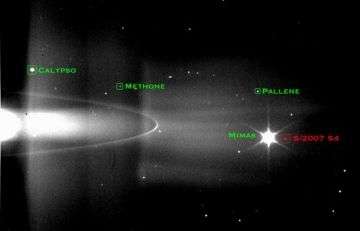A new moon for Saturn – a family affair

Scientists from the NASA/ESA/ASI Cassini mission have announced the discovery of a new moon orbiting Saturn, bringing the total number of known moons in the Saturnian system to 60.
This latest satellite was first detected by Professor Carl Murray, a Cassini Imaging Team scientist from Queen Mary’s Astronomy Unit. It was found in a series of images taken from the wide-angle camera onboard Cassini on 30 May 2007.
Initial calculations, which show the moon to be only approximately 2 km (1 mile) wide, indicate that the orbit of the moon lies between those of two other Saturnian moons, Methone and Pallene (also discovered by the Cassini Imaging Team in 2004).
Professor Murray takes up the story: “The Saturnian system continues to amaze and intrigue us with many hidden treasures being discovered the more closely we look. After initially detecting this extremely faint object, we carried out an exhaustive search of all Cassini images to date and were able to find further detections.
“The latest discovery suggests that the three satellites may form part of a family of moons in this region. Naturally we are going to use Cassini’s cameras to search for additional family members.”
Professor Murray was also the first person to detect another moon of Saturn, Polydeuces, seen in Cassini images in October 2004. However, he is keen to emphasise the collaborative nature of this work. “Finding new moons and working out their orbits is a group effort. The credit for both of these discoveries should go to the entire Cassini Imaging Team.”
The closest approach to the satellite to date was on 28 June 2007 when Cassini passed at a distance of 32,000 km. Scientists hope to be able to get a closer look at the newly identified moon later in the mission.
Affectionately known as “Frank” to the Queen Mary scientists that first identified it, the satellite is set to have a more fitting name assigned to it – akin to its ‘cousins’ Methone and Pallene - who are named after the Greek Alkyonides. This is a decision for the International Astronomical Union (IAU) – the body responsible for officially naming planetary objects. So far only 48 of the 60 moons discovered have been given names. ‘Frank’ has received the preliminary designation S/2007 S 4 by the IAU. See notes to editors for further details about the naming of moons.
Professor Keith Mason, CEO of the UK’s Science and Technology Facilities Council (STFC) commented: “It is amazing to think that when Cassini embarked upon its epic journey to Saturn in 1997, we only knew about 18 of its moons. Since then, through observations from ground based telescopes and the Cassini spacecraft, a further 42 have been identified!”
Source: Queen Mary, University of London





















